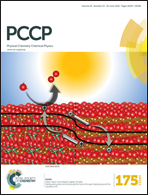Solubility of alkali metal halides in the ionic liquid [C4C1im][OTf]†
Abstract
The solubilities of the metal halides LiF, LiCl, LiBr, LiI, NaF, NaCl, NaBr, NaI, KF, KCl, KBr, KI, RbCl, CsCl, CsI, were measured at temperatures ranging from 298.15 to 378.15 K in the ionic liquid 1-butyl-3-methylimidazolium trifluoromethanesulfonate ([C4C1im][OTf]). Li+, Na+ and K+ salts with anions matching the ionic liquid have also been investigated to determine how well these cations dissolve in [C4C1im][OTf]. This study compares the influence of metal cation and halide anion on the solubility of salts within this ionic liquid. The highest solubility found was for iodide salts, and the lowest solubility for the three fluoride salts. There is no outstanding difference in the solubility of salts with matching anions in comparison to halide salts. The experimental data were correlated employing several phase equilibria models, including ideal mixtures, van't Hoff, the λh (Buchowski) equation, the modified Apelblat equation, and the non-random two-liquid model (NRTL). It was found that the van't Hoff model gave the best correlation results. On the basis of the experimental data the thermodynamic dissolution parameters (ΔH, ΔS, and ΔG) were determined for the studied systems together with computed gas phase metathesis parameters. Dissolution depends on the energy difference between enthalpies of fusion and dissolution of the solute salt. This demonstrates that overcoming the lattice energy of the solid matrix is the key to the solubility of inorganic salts in ionic liquids.
![Graphical abstract: Solubility of alkali metal halides in the ionic liquid [C4C1im][OTf]](/en/Image/Get?imageInfo.ImageType=GA&imageInfo.ImageIdentifier.ManuscriptID=C6CP02286C&imageInfo.ImageIdentifier.Year=2016)

 Please wait while we load your content...
Please wait while we load your content...